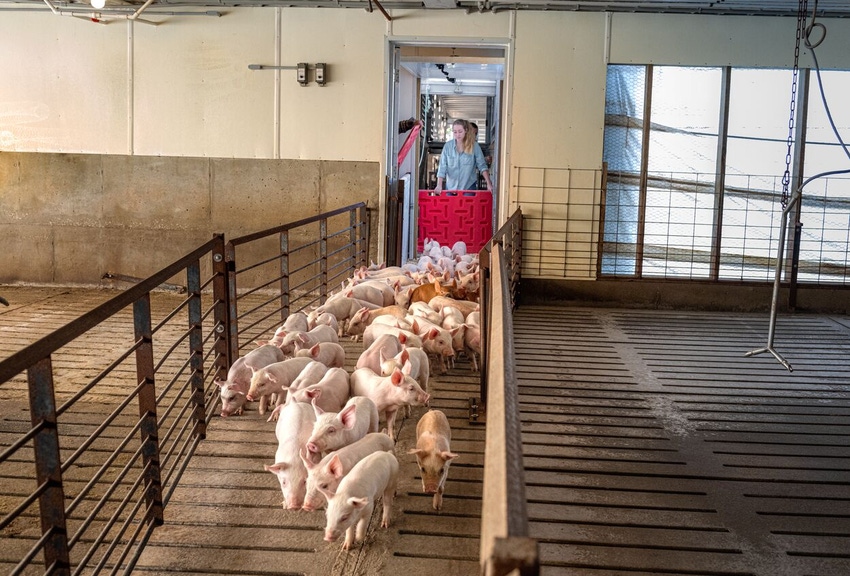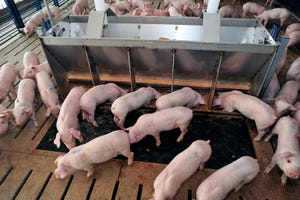Sustainability in large-scale pig production
Swine welfare, food supply and designs for the future.
August 23, 2023

By Isabella Rivera, SwineTech
As many know, the ever-elusive ideal of “sustainability” has been circling news outlets, business and even trend cycles more and more in the past few years. However, with so much dialogue around one topic, it can be difficult to pick out the meat of the conversation, particularly in industries as large as the agricultural sector.
Many are in favor of working toward a sustainable future, but what does that look like? What, realistically, can be done to work toward it? And maybe most confusingly, how are farmers meant to be both environmentally conscious and meet the nutrition needs of the population? Particularly in the pork industry in the United States, which produces on a large enough scale to impact the world, it’s crucial to examine where producers stand in the development of a greener global food supply.
Putting people first
As one examines sustainability in agriculture, it’s crucial to first understand that environmental protections must meet in the middle with ramifications for humans. Sustainability is not as cut and dry as, for instance, simply reducing emissions or conserving water supply.
While both concepts are admirable goals, producers, particularly smaller, family-owned farms need realistic, staggered plans that allow change to occur on a reasonable timeframe and in an economically feasible manner. For example, massive overhauls of barn layouts required for compliance with any one regulation demand costs that smaller producers can’t keep up with.
Pork is about supporting people, and that includes its producers. However, considering sustainability in agriculture also requires admitting that scaling back the extent of livestock production has negative consequences for a consumer, too.
According to the FAO, livestock production accounts for 40% of the world’s total agricultural output, 34% of the global protein supply, and the health and livelihoods of approximately 1.3 billion people, not to mention pork’s role in the cuisine of many different cultures. Livestock production is more than what it consumes environmentally—it’s the reality of what supplies food for the world. Encouraging growth in agriculture is the only way forward to create efficient systems that both feed as many mouths as possible and care for the earth those people live on. In fact, the past few decades have already proved that.
Among other measures, over the last 40 years, better understanding of genetics, feeding systems, and biosecurity hazards have evolved to decrease requirements for production of livestock by 20% while doubling overall livestock output. Those working in agriculture rightly believe that there can be an economical middle ground between environmental concerns and consumer demand, so what technologies have pushed farming to its ever-improving status quo?
Enhancing animal welfare and production efficiency
Beginning perhaps with the most controversial element of pork production, animal welfare has improved tremendously in pig farming over past decades, and that is largely due to a massive but gradual shift from outdoor farming to indoor production as the norm in the industry.
Outside the circles of those that work in pork, there is often the notion that indoor spaces are confining or uncomfortable for pigs, but the truth is that climate-controlled environments suit the needs of pigs best due to their inability to sweat and, therefore, regulate their body temperature to avoid potentially lethal heat stress. Alongside this, indoor facilities, as well as the development of management technologies within them (ex: the Meal Meter), allow farmers to control the amount of feed and water going to each animal to create conditions where each pig can best thrive.
Furthermore, ventilation systems and other biosecurity measures that can be implemented due to the structure of indoor facilities prevent the spread of disease and parasites between animals, reducing previously widespread problems such as mange and rabies. These measures have created a 40% increase in farrowing rate throughout the industry over the past several decades, leading to simultaneously more pork and happier, healthier pigs.
But looking to the future, what advancements are coming down the pipe for large-scale production? What are realistic next steps for businesses to take to move toward a greener future?
Innovations and case studies in sustainable pig production
While there is ongoing research into sustainable farming practices happening worldwide, the Australian pork industry, which is smaller than in nations such as the U.S. and China but mightily minded, presents interesting case studies for the future of pig production.
For example, the Australian producer SunPork has eliminated the use of sow stalls in its facilities. These housing units, while important in many barns to reduce crushing incidents and provide individualized care, have long been the targets of animal welfare groups concerned with lack of space given to sows in these units. SunPork has managed to remove them entirely from their standard practices by investigating practices to reduce aggression between animals, and that creates exciting prospects for bigger industries.
Also receiving more research from academics within agriculture is the idea of immunocastration, or the idea of castrating pigs via a vaccine in place of the traditional surgical method. This idea does respond to consumer concern over animal welfare, but data is also beginning to show that immunocastration could reduce boar taint to increase meat quality, which is promising for producers as well.
Another measure that promotes animal welfare and reduces waste is the invention of better supervising systems within barns. Many companies are using AI technology to collect audio, visual, and temperature-based data about their pigs, but technologies that can combine data collection, communication within teams, and process compliance, such as PigFlow, support better employee engagement and execution of key processes that are invaluable to farmers seeking to improve efficiency and care on their farms.
When producers know what’s going on in their barns, they are better able to respond to issues, environmental or otherwise, as they occur. In conjunction with practices like precision feeding, where farmers alter how they feed pigs based on the objective of the facility raising them, technology that offers more information to farmers allows those in the industry to make smart choices to reduce waste and grow a healthy pig.
As far as reducing waste on a larger scale, many farms are already in the practice of using byproducts and other waste grain products that aren’t safe for human consumption for feed. Along with other practices that make smart use of pre-existing resources, such as sourcing fertilizer for grain crops from the farms that will eventually use them as feed, these old ideas can work alongside new ones to create a sustainable future for people, pigs, and the planet.
Sustainability remains a concept that’s difficult to pin down as action in any one area, but when producers take a multi-dimensional approach to caring for the earth and the people and animals that live on it, they produce innovative results that have benefits for both the environment and the industry. Pork has already made plenty of progress in its efforts to be an industry that works for the future, and the possibilities for continuing that development are endless.
You May Also Like



